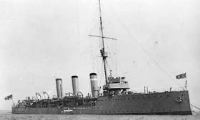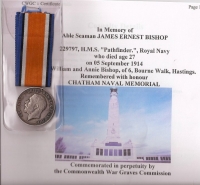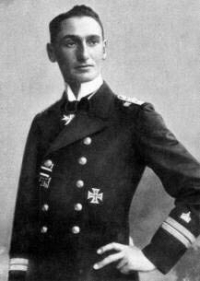1914-1918 Silver War Medal (Casualty HMS Pathfinder)
(Silver War Medal Without Suspender)
*Also entitled to 1914-15 Star and Victory Medal as Bishop, although an early casualty in home waters "served at sea" from 5th August 1914 .
To:
229797. Able Seaman JAMES ERNEST BISHOP. R.N.
KILLED IN ACTION 5th SEPTEMBER 1914.
H.M.S PATHFINDER.
THE FIRST SHIP EVER TO BE SUNK BY TORPEDO FROM A SUBMARINE
The Sinking
At the beginning of September 1914 Otto Hersing of U-21 ventured to the Firth of Forth, home to the major British naval base at Rosyth. Hersing is known to have penetrated the Firth of Forth as far as the Carlingnose Battery beneath the Forth Rail Bridge. At one point the periscope was spotted and the battery opened fire but without success. Overnight Hersing withdrew from the Forth, patrolling the coast from May Island southwards. From a distance, on the morning of 5 September he observed the SSE course of HMS Pathfinder followed by elements of the 8th Destroyer Flotilla. The destroyers altered course back towards May Island at midday while HMS Pathfinder continued her patrol. Hersing spotted Pathfinder on her return journey from periscope depth at 1530. This time he resolved to make an attack. At 1543 Otto Hersing fired a single 19.69” Type G torpedo.
5 September was a sunny afternoon. At 1545 lookouts spotted a torpedo wake heading towards the starboard bow at a range of 2,000 yards. The officer of the watch, Lieutenant-Commander Favell gave orders for the starboard engine to be put astern and the port engine to be set at full ahead while the wheel was fully turned in an attempt to take avoiding action. At 1550 the torpedo detonated beneath the bridge.
The cordite charges may have then been ignited, leading to a flash causing a second, massive explosion within the fore section of the ship as the magazine blew up. The fore mast and No 1 funnel collapsed and then toppled over the side. The forensic evidence of the wreck is that everything before the first funnel disintegrated. The majority of the crew below decks in the forward section had neither the time nor the opportunity to escape. Although the explosion was well within sight of land, Captain Martin-Peake knew it was essential to attract attention. He ordered the stern gun to be fired. The king-pin must have been fatally damaged by the explosion because after firing a single round, the gun toppled off its mounting, rolled around the quarter deck, struck the after screen then careered over the stern, taking the gun crew with it. There was no list but there was insufficient time to lower boats. Indeed the remains of a lifeboat davit and rope can still be seen on the wreck. The propeller belonging to the ship’s boat lies on the deck nearby.
Lt (E) Stallybrass recalled that the bulkheads held firm until five minutes after the big explosion:
|
“ |
The ship gave a heavy lurch forward and took an angle of about forty degrees down by the bow. Water came swirling up to the searchlight platform. The Captain said, ‘jump you devils jump !’. The Captain and his secretary remained with the ship until the very end but somehow both survived” |
” |
The bow section sheared off under the strain as the stern heaved up to a sixty degree angle. Then it quietly slipped below the surface.
Eyemouth fishing boats were first on the scene and encountered a field of debris, fuel oil, clothing and body parts. Destroyers HMS Stag and Express had spotted the smoke and headed for the pall of smoke. One of the destroyers had an engine problem when a water inlet was blocked by a leg in a seaboot.
There is significant confusion regarding the numbers of survivors. On 6 September The Times declared that 58 men had been rescued but that four had died of injuries. The fact that it is impossible to determine how many were on board that day, adds to difficulties but research indicates that 268 personnel were onboard plus two civilian canteen assistants. There were just eighteen known survivors:
Captain Francis Martin-Leake Ernest Stallybrass, Lt (E) Bath Alan G Lt. Paymaster
Bannister A Stoker, Brett Wm OS, Bruce, Stanley ERA, Fothergill Reg, AB, Jones, P, Mechanician, Kevan, S, L./Sig, Lewis E Stoker, Marland J Pte RMLI, Noy, J Stoker, Pring, wm, Stoker, Rogers, Wm Boy, Smyth, Thomas, Staff Surgeon, Trimming, Alfred Boy, Mcdermott A L/Stoker, Marriot, Charles, AB,
Four more men died of injuries or exposure and are buried at Dalmeny in Fife and Warriston near Edinburgh. One unknown Pathfinder sailor is buried at Dunbar overlooking the scene of the sinking.
The explosion was seen by Aldous Huxley (while staying at Northfield House, St. Abbs) who recorded the following in a letter to his father sent on 14 September 1914:
I dare say Julian told you that we actually saw the Pathfinder explosion — a great white cloud with its foot in sea. The St. Abbs' lifeboat came in with the most appalling accounts of the scene. There was not a piece of wood, they said, big enough to float a man—and over acres the sea was covered with fragments—human and otherwise.
They brought back a sailor's cap with half a man's head inside it. The explosion must have been frightful. It is thought to be a German submarine that did it, or, possibly, a torpedo fired from one of the refitted German trawlers, which cruise all round painted with British port letters and flying the British flag.
Despite the events of 5 September having been easily visible from shore, the authorities attempted to cover up the sinking and Pathfinder was reported to have been mined. Admiralty came to an agreement with the Press Bureau which allowed for the censoring of all reports. The Scotsman however published an eye-witness account by an Eyemouth fisherman who had assisted in the rescue. The account confirmed rumours that a submarine had been responsible, rather than a mine. However The Scotsman also reported that Pathfinder had been attacked by two U-boats and had accounted for the second one in her death throes. Admiralty intelligence later claimed that cruisers had cornered the U-boat responsible and shelled it to oblivion. The sinking of Pathfinder by a submarine made both sides aware of the potential vulnerability of large ships to attack by submarines.
Medal without suspender. (GVF)
£95.00



